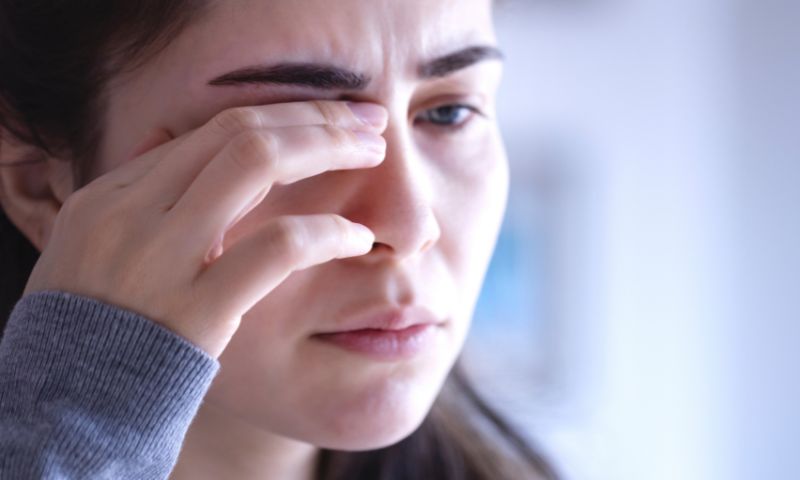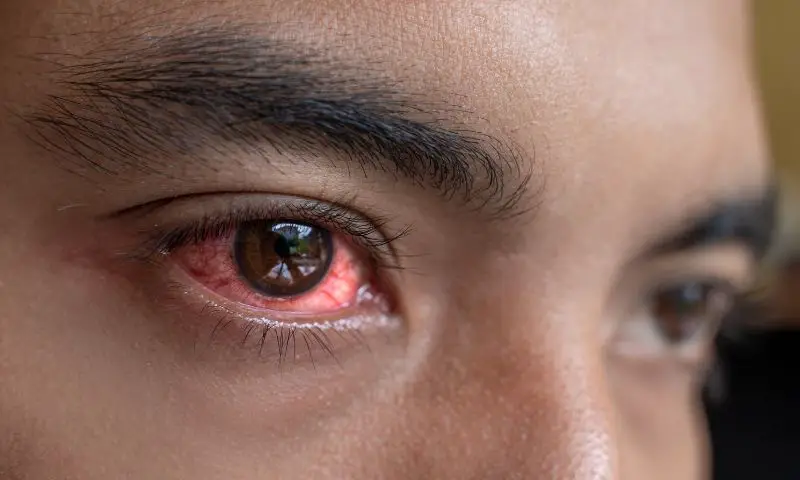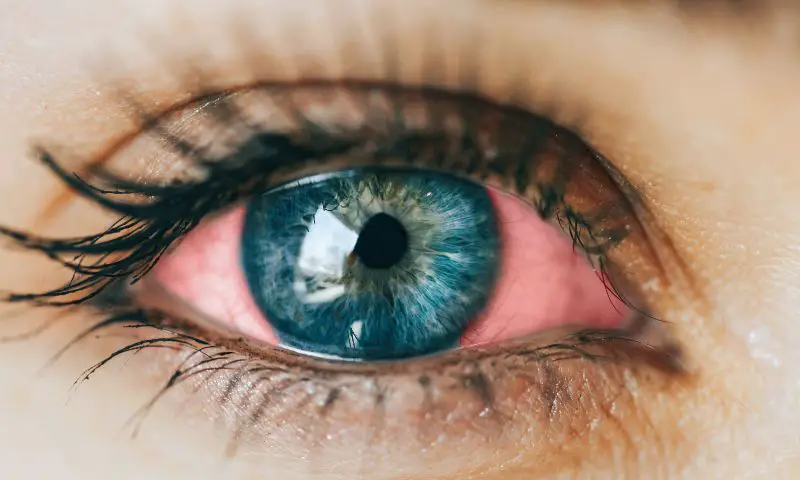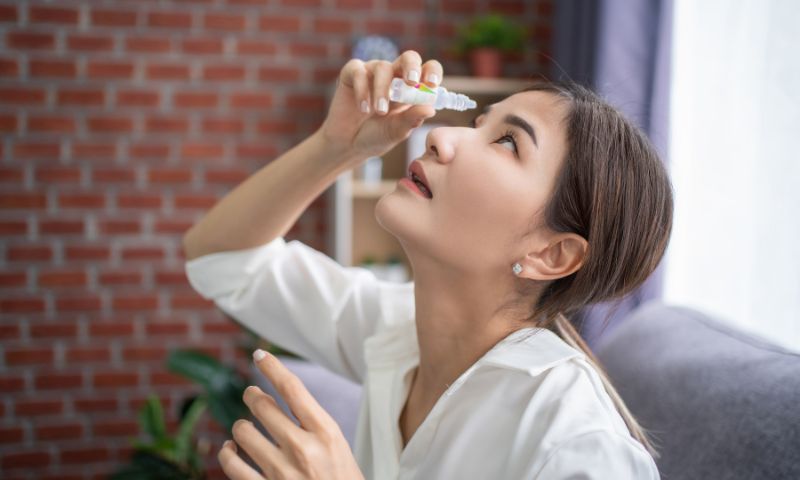Eye Flu, also termed as ‘pink eye’ or ‘bacterial conjunctivitis’, is a prevalent eye infection caused by certain bacteria or viruses. It primarily impacts the conjunctiva, the clear, thin layer covering the front surface of the eye, resulting in inflammation, irritation, redness, and a sense of discomfort akin to having a foreign body in the eyes. Bacterial conjunctivitis typically exhibits symptoms like a sticky discharge, often yellowish, and can affect one or both eyes.
Eye Flu caused by a virus is highly contagious and can easily spread through direct contact. It may be associated with a common cold or respiratory infection. It’s crucial to be aware of these conditions for timely and accurate treatment.
While bacterial conjunctivitis requires antibiotics, viral conjunctivitis usually resolves spontaneously within a couple of weeks. Regular hand washing and avoiding sharing personal items can help prevent the spread of this infection.
How Is Eye Flu Caused?

Eye flu, also known as viral conjunctivitis or pink eye, is caused by a virus. The most common cause of eye flu is the adenovirus, which is easily transmitted from person to person.
It can spread through direct contact with an infected person or by touching contaminated surfaces and then touching the eyes. Another less common cause is a bacterial infection, known as bacterial conjunctivitis.
What Are Eye Flu Symptoms?

The symptoms of eye flu include redness, itching, and a watery discharge from the eyes. In some cases, the infection can also cause sensitivity to light and blurred vision. Other causes of eye flu include allergies, irritants, and underlying health conditions. It is important to note that eye flu can also cause eye infections, which can lead to more serious complications if left untreated. Therefore, it is crucial to seek medical attention if experiencing any symptoms of eye flu.
The most common eye flu type is viral conjunctivitis, which is highly contagious. It is characterized by redness, tearing, and itching in the eyes.
Additionally, viral conjunctivitis may cause eye discharge, which can be watery or thick and yellow in color. Bacterial conjunctivitis, another type of eye flu, can also cause redness and irritation in the eyes.
However, it is usually accompanied by a sticky eye discharge that may be green or yellow in color. Allergic conjunctivitis, on the other hand, is not contagious. It is often caused by allergies such as pollen or pet dander and leads to red, itchy, and watery eyes.
In all cases, if experiencing any eye flu symptoms, it is important to seek medical attention and avoid touching or rubbing the eyes to prevent further irritation or spreading the infection.
How Does Eye Flu Spread?

One of the most common ways to contract eye flu is by rubbing your eyes with hands that have come into contact with the virus.
This action allows the virus to enter the body through the mucous membranes of the eyes. Additionally, eye flu can also spread through respiratory droplets produced when an infected person coughs or sneezes.
Therefore, it is crucial to practice good eye hygiene and avoid touching your eyes with unwashed hands.
It is recommended to frequently wash hands thoroughly with soap and water, especially after coming in contact with people who have eye flu symptoms or contaminated surfaces. By maintaining proper eye hygiene and taking precautions, the spread of eye flu can be minimized.
What Are The Prevention Measures To Control Eye Flu Symptoms?

To prevent the spread of eye flu and its symptoms, there are a few important prevention measures to follow.
First and foremost, it is crucial to avoid touching your eyes or the surrounding eye area, as this can transfer the virus from your hands into your eyes.
Refrain from sharing personal items such as towels, pillowcases, or eye makeup with others, as this can also spread the infection.
If you wear contact lenses, make sure to follow proper hygiene practices, such as washing your hands before handling them and regularly cleaning and disinfecting the lenses.
It is also recommended to frequently wash your hands with soap and water or use hand sanitizer, especially after coming into contact with surfaces that may be contaminated.
By practicing these prevention measures and maintaining good hygiene, you can significantly reduce the risk of contracting and spreading eye flu.
What Are Eye Flu Treatment Options?

Fortunately, there are various treatment options available to alleviate the symptoms and promote a faster recovery.
The most common eye flu treatment includes regular application of warm compresses on the affected eye, as this helps soothe the irritation and reduce swelling.
It is also important to avoid wearing contact lenses until the infection has cleared up, as these can further irritate the eye and delay the healing process.
Touching your eyes should be avoided to prevent spreading the infection to the other eye or to others. In some cases, over-the-counter lubricating eye drops may be recommended to moisturize and provide temporary relief from dryness or discomfort.
However, it is always essential to consult with a healthcare professional before beginning any eye flu treatment to ensure proper care and prevent any complications.
Types of eye flu or conjunctivitis

There are different types of eye flu, including viral, bacterial, and allergic conjunctivitis. Viral conjunctivitis is caused by a virus and is highly contagious, often spreading through contact with infected individuals or contaminated objects.
Bacterial conjunctivitis is caused by bacteria and can also be contagious, commonly transmitted through direct contact with eye discharge or sharing eye makeup or contact lenses.
Allergic conjunctivitis, on the other hand, is triggered by an allergen and is not contagious. Symptoms of conjunctivitis may include red and swollen eyes, itching, burning sensations, excessive tearing, and eye discharge.
Treatment options for conjunctivitis vary depending on the underlying cause and may include eye drops, antiviral or antibiotic medications, or allergy shots.
Best Monsoon Eye Care Tips During North India’s Rainy Season
During North India’s rainy season, it is essential to take proper care of our eyes to prevent any discomfort or infections.
The monsoon season brings with it an increase in humidity levels and the risk of waterborne diseases, which can adversely affect our eyes. One of the most important eye care tips during this time is to always keep our eyes clean and free from dust or pollutants.
Washing our eyes regularly with clean water can help remove any irritants and reduce the risk of infections.
It is also advisable to avoid rubbing our eyes with dirty hands as it can introduce harmful bacteria. Additionally, wearing sunglasses with UV protection can help shield our eyes from harmful rays and minimize exposure to dust and pollutants.
Moreover, staying hydrated and having a nutritious diet that includes foods rich in vitamins and antioxidants can contribute to the overall health of our eyes during the monsoon season. By following these simple eye care tips, we can ensure our eyes are well-protected and maintain optimal health throughout the rainy season.
When to see a doctor for eye flu?

If you are experiencing symptoms of eye flu, such as redness, itching, and a watery or gritty feeling in your eyes, it is important to seek medical attention from an eye doctor.
If you wear contact lenses, it is especially important to see a doctor if you suspect eye flu, as the infection can cause serious complications for your eyes and vision.
Although the symptoms of eye flu may improve on their own within a few days, it is crucial to consult a doctor if the symptoms persist or worsen. Additionally, if you notice any discharge from your eye, particularly if it is yellow or green in color, it is important to seek immediate medical attention.
A doctor can provide a proper diagnosis and prescribe appropriate treatment to alleviate your symptoms and prevent the spread of the infection.
It is always better to be on the safe side and consult a doctor when experiencing symptoms of eye flu.
Which medicine is best for eye flu?

When it comes to treating eye flu, there are several medications that can provide relief and alleviate symptoms. One common over-the-counter option is artificial tears or lubricating eye drops.
These drops provide moisture and help soothe dryness and discomfort caused by eye flu. Antiviral eye drops may also be prescribed in cases where the flu is caused by a viral infection, helping to combat the virus and speed up recovery.
In more severe cases, antibiotic eye drops or ointments may be necessary if there is a bacterial infection present.
These medications are prescribed by a healthcare professional and work to eliminate the bacterial growth and reduce inflammation. It is important to consult with a doctor or ophthalmologist to determine the best course of treatment based on the specific symptoms and underlying cause of the eye flu.
They will be able to provide guidance and recommend the most suitable medication to relieve discomfort and promote healing.
How long does an eye flu last?
The duration of eye flu can vary depending on the type and severity of the infection. In most cases, viral conjunctivitis, which is the most common form, tends to resolve on its own within one to two weeks.
Bacterial conjunctivitis can also clear up relatively quickly with proper treatment, such as antibiotic eye drops or ointments.
However, if left untreated, bacterial conjunctivitis may last longer and potentially lead to more serious complications. Allergic conjunctivitis, caused by a reaction to allergens, can last as long as the allergen is present or until the individual takes steps to remove or avoid exposure to the allergen.
It is important to consult a healthcare professional for an accurate diagnosis and appropriate treatment to ensure the quickest resolution of eye flu symptoms.
What is the fastest way to cure eye flu?

The fastest way to cure eye flu is to seek medical attention and follow the prescribed treatment plan.
To alleviate symptoms and promote healing, it is important to avoid touching or rubbing the eyes, as this can worsen the condition and spread the infection. Applying a warm compress to the affected eye can provide relief from discomfort.
Additionally, over-the-counter eye drops may help reduce redness and itchiness, but it is important to consult with a healthcare professional before using any medication.
Proper hygiene, such as regularly washing hands and avoiding sharing makeup or towels, can also aid in preventing the spread of eye flu.
How do you know if you have the flu in your eyes?
If you have the flu, it is possible for your eyes to be affected. The most common symptom is redness and inflammation in the eyes.
You may also experience watery discharge and itchiness. The flu virus can cause viral conjunctivitis, which is an inflammation of the conjunctiva, the clear layer that covers the white part of the eye and inner surface of the eyelids.
This condition usually occurs in conjunction with other flu symptoms such as fever, cough, and body aches. If you suspect you have the flu and notice any of these eye symptoms, it is important to seek medical attention to receive proper treatment and prevent the spread of the virus.
Does eye flu go away on its own?
Eye flu, or conjunctivitis, can sometimes go away on its own without treatment. However, this depends on the cause of the infection. If it is viral, it may take a week or two to clear up on its own.
Bacterial conjunctivitis, on the other hand, typically requires antibiotic eye drops or ointment to completely resolve. Allergic conjunctivitis may also improve without intervention, but managing the underlying allergy will prevent future flare-ups. It is always advisable to consult an optometrist or ophthalmologist if symptoms persist or worsen, as they can provide appropriate guidance and treatment options to ensure a full recovery.
How can I treat eye flu at home?

If you have eye flu and want to treat it at home, there are a few remedies you can try. Firstly, you can apply warm compresses to the affected eye multiple times a day to relieve discomfort and reduce swelling.
You can also use over-the-counter artificial tears or lubricating eye drops to soothe dryness and provide relief.
However, it is important to avoid sharing towels or touching your eyes with unwashed hands to prevent the spread of infection.
Make sure to clean your eyeglasses or contact lenses properly to avoid further irritation. If your symptoms worsen or persist, it is advisable to seek medical attention.
Disclaimer: The information in this article is intended for general knowledge only. For any medical concerns regarding eye flu, always consult a licensed physician or eye doctor for proper diagnosis and treatment.


Leave a Reply